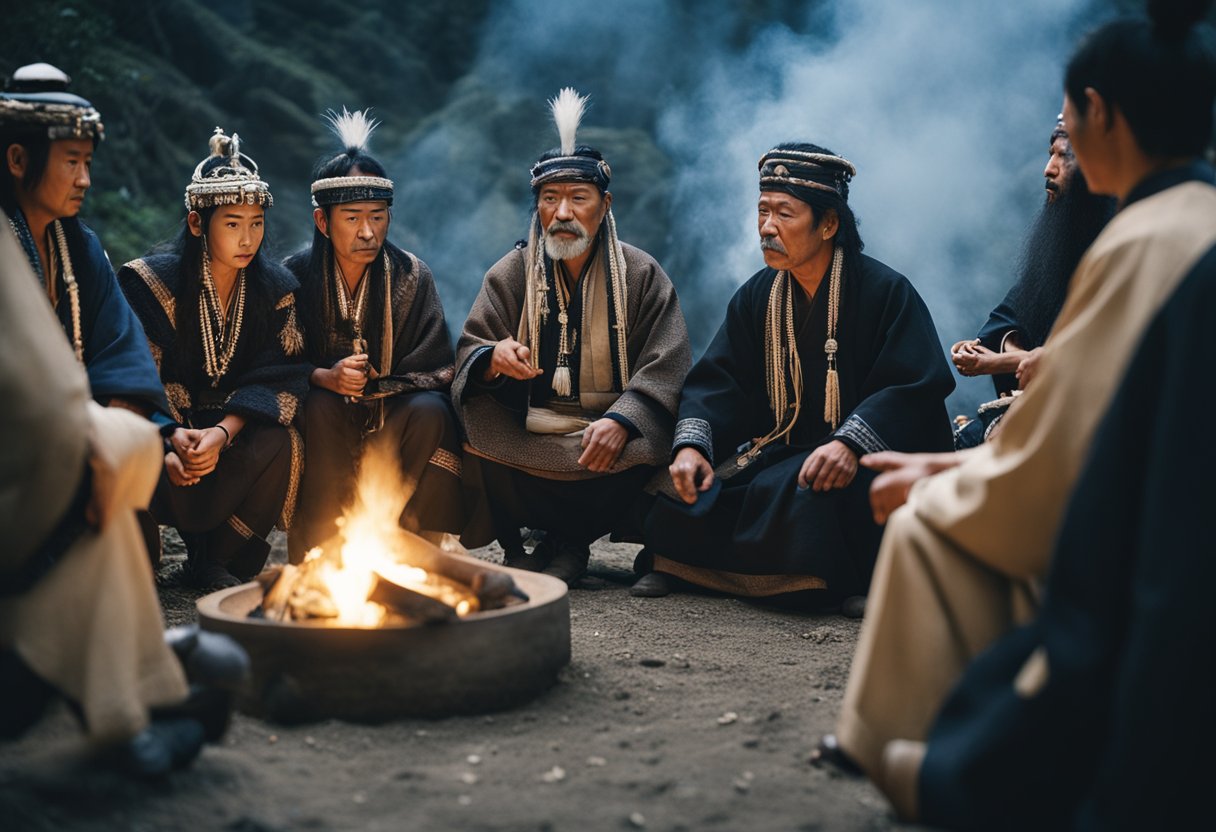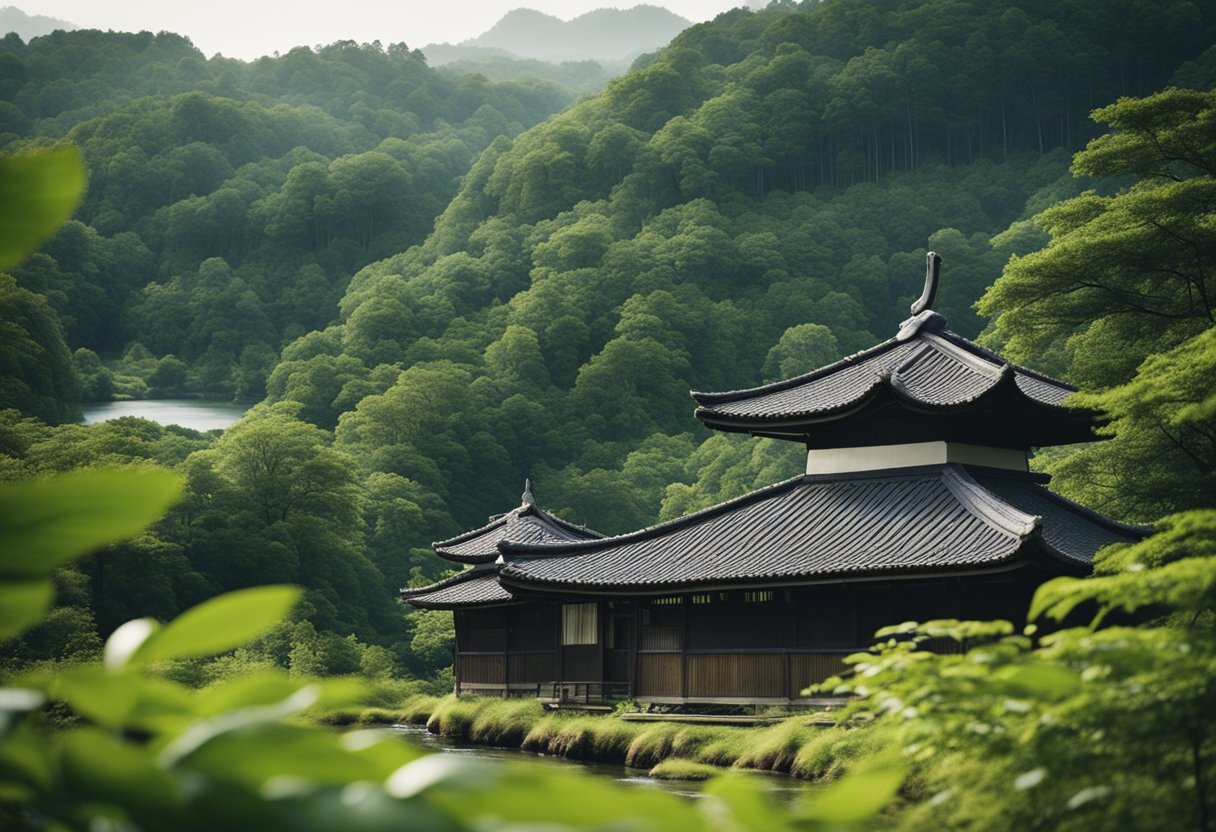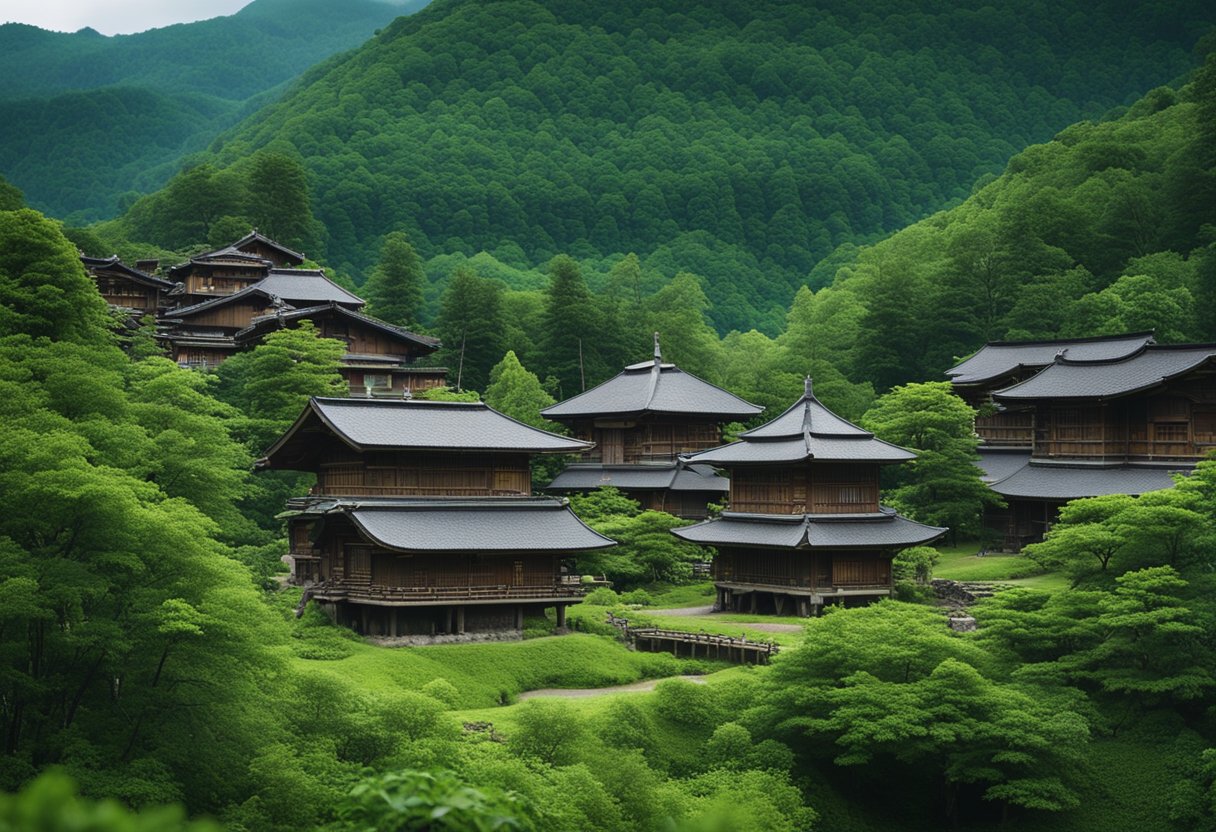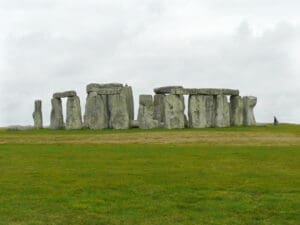The Ainu People: Unveiling Japan’s Indigenous Culture and Ancestral Heritage

Updated On: April 22, 2024 by Eman Sameh
The Ainu people, often regarded as Japan’s indigenous community, have a distinct and rich cultural heritage that stands apart from the more widely recognised Japanese culture. Primarily inhabiting regions such as Hokkaido and historically present in Sakhalin and the Kuril Islands, the Ainu have maintained a unique identity with their own language, spiritual beliefs, and social customs. Despite the pressures of assimilation and historical marginalisation, the Ainu community continues to persevere, nurturing and promoting their ancient traditions.

Understanding the Ainu’s history offers a broader insight into human diversity and the complex tapestry of cultural identities in Japan and the broader North Asian region. The community’s ongoing efforts to preserve their language and traditions amid the modern societal landscape underscore the resilience and significance of indigenous cultures worldwide.
Origins and Early History
The Ainu people have a rich history that is deeply interwoven with the Japanese archipelago, particularly the northern regions such as Hokkaido. Their origins are a complex tapestry of influences and interactions that still resonate in Ainu culture today.
Jomon Influences
The Ainu are thought to be descendants of the Jomon people, a prehistoric ethnic group that inhabited Japan from about 14,000 BC. Distinct Jomon influences are evident in Ainu cultural practices, art, and spirituality. The artefacts and patterns seen in Ainu craftsmanship reflect a continuity that has persisted for centuries.
Interactions With The Okhotsk
We also see a significant cultural influence stemming from the interactions between the Ainu and the Okhotsk culture. These interactions, which primarily occurred in northern territories such as Hokkaido and the northern parts of Honshu, contributed to the distinctive practices within the ethnic group. The blending of cultures is apparent in various aspects of daily life, such as fishing and hunting techniques, which have been vital for the Ainu’s subsistence.
Ainu Language and Communication
In exploring Japan’s indigenous heritage, the Ainu language emerges as a distinctive yet critically endangered aspect of the Ainu culture. Serving as a cornerstone of their ethnic identity, its preservation remains a poignant challenge.
Endangered Dialects
The Ainu language is considered to be an isolated language, meaning it does not belong to any recognised language family. The language is categorised as critically endangered with less than a handful of fluent speakers remaining. Efforts are underway to revitalise this unique mode of communication, ensuring that the Ainu people do not lose this integral part of their cultural DNA.
The Role of Yukar in Preserving Culture
Yukar, or Ainu epics, serve as a vital medium for conveying oral history and culture. These narrative songs or poems are traditional Ainu oral literature and have been pivotal in transmitting heritage and values through generations. In recitations, the historical events, cosmology, and legends of the Ainu race are passed down, thus safeguarding their ancient wisdom and practices.
Social Structure and Everyday Life

In exploring the Ainu people’s social structure and everyday life, we shed light on their hunter-gatherer lifestyle and agricultural practices, which are the bedrock of their community living and cultural identity.
Hunter-Gatherer Lifestyle
The Ainu, indigenous to northern Japan and surrounding regions, primarily led a hunter-gatherer lifestyle, depending heavily on the bounty provided by their land and waters. Hunting and fishing were not merely means of sustenance; they were deeply woven into the traditions and society of the Ainu. Men would engage in bear hunting—an animal with significant cultural importance—and deer hunting, while fishing in Hokkaido’s rivers was crucial. Conversely, women often partook in gathering plants, nuts, and shells, adding variety to their food resources.
Agricultural Practices
Although traditionally hunter-gatherers, the Ainu also developed agricultural practices to supplement their diet. They cultivated grains such as millet, and their agricultural techniques were well-adapted to their environment. The Ainu’s interaction with the Wajin (ethnic Japanese) also affected their agricultural methods with exchanges of practices over time. However, agriculture played a secondary role compared to their primary food sources derived from hunting and fishing activities.
Religious Beliefs and Rituals

In exploring the rich tapestry of Ainu culture, we find their religious beliefs and rituals deeply rooted in nature and ancestor worship, emphasising various ceremonies and the veneration of the kamuy, or spiritual deities. The Ainu’s worldview is anchored in an intricate system of beliefs where both animate and inanimate entities are imbued with spiritual significance.
Kamuy and the Spiritual World
The Ainu people recognise a pantheon of kamuy, a term denoting gods or spirits that inhabit the natural world around them. We see an animistic view in their culture, where gods are believed to exist in elements of nature – from mountains and rivers to the sun and the moon. Legends tell us that these spirits would travel to the world of humans via the Milky Way, which the Ainu call “the river of heaven”. Essential to their religious practice is the holding of various rituals to honour these deities and to ensure peace and balance between the spiritual and human realms. Reverence for nature is a cornerstone of Ainu spirituality, and their embroidery often depicts patterns symbolising natural elements and kamuy.
Bear Worship and Rituals
Bare worship or astrolatry holds a special place within Ainu traditions among the numerous ceremonial practices. The bear is considered the chief among animals and as such, a major kamuy in Ainu religion. We observe one of their most significant rituals, Iomante, centred around the sending back of the bear spirit to the heavens. This practice involves the ceremonial raising and then sacrifice of a bear, a clear embodiment of their respect for the bear’s spirit. The Ainu believe this ritual ensures the kamuy’s goodwill towards the people. The veneration of the bear depicts the intertwined relationship the Ainu have with wildlife, reaffirming their profound respect and symbiotic connection with nature.
Cultural Expressions
The Ainu people’s cultural expressions are deeply rooted in their music and craftsmanship, reflecting a heritage rich in tradition and artistic ingenuity.
Traditional Ainu Music
Ainu music, central to their cultural identity, is characterised by a distinct vocal style known as Upopo, which is traditionally performed in a group. The interplay of repetitive rhythms and call-and-response singing mirrors the communal nature of their society. Instruments such as the Tonkori, a plucked string instrument, play a crucial role in their auditory heritage, echoing the sounds of natural elements and conveying stories.
Ainu Crafts and Wood Carving
The rich Ainu crafts tradition showcases skilful wood carving, which is not only an art form but a conduit of their spiritual beliefs. Their carvings often depict animals which they hold sacred, symbolising a deep reverence for nature. Items such as Itaomachip and Inau serve both functional and ceremonial purposes. Ainu craftsmen are renowned for their intricate patterns and detail, which have been passed down through generations.
Ainu and the Japanese Government

In our exploration of the relationship between the Ainu people and the Japanese government, we shall underscore the historical challenges and the progressive steps towards the recognition and rights of the Ainu.
Historical Discrimination and Assimilation
For many years, the Ainu people experienced systemic discrimination and were subjected to various assimilation policies. Under measures such as the Former Aborigines Protection Act, the Ainu were forcibly integrated into Japanese society, deprived of their land and fishing rights, and their cultural identities were suppressed. This act was part of Japan’s broader agenda to incorporate Hokkaido into its territory, often disregarding the human rights of the Ainu.
Towards Recognition and Rights
Moving from a past riddled with injustice, the Japanese government has taken steps towards amending its relationship with the Ainu. Finally, receiving official recognition as an indigenous people by the Japanese Diet in 2008 marked a significant milestone. It laid the groundwork for establishing policies upholding the cultural and societal contribution of the Ainu. Further, Japan’s development of the Symbolic Space for Ethnic Harmony symbolises a commitment to the revival and development of Ainu culture, promoting understanding among the wider society. Recognising these strides, we must continue to monitor progress made in the courts and legislative bodies to ensure the rights of the Ainu are respected and preserved.
Preservation of Heritage

In our efforts to safeguard the rich cultural tapestry of the Ainu people, we turn to museums, educational initiatives, and language revival programs, which serve as critical avenues for preserving this invaluable heritage.
Role of Museums and Cultural Parks
Museums and cultural parks play an indispensable role in protecting and celebrating Ainu heritage. The National Ainu Museum and Park in Shiraoi, known as Upopoy, is a vital space to disseminate knowledge and offer immersive experiences. Upopoy, meaning “singing in a large group” in the Ainu language, is Japan’s first national museum dedicated to the indigenous Ainu culture, providing visitors with the opportunity to engage first-hand with Ainu traditions, from crafts to performances. Similarly, the Sapporo Pirka Kotan, a museum located in the Sapporo area, showcases Ainu culture and history through exhibitions and workshops, thereby contributing to the appreciation and understanding of Ainu heritage.
Educational Initiatives and Language Revival
Our commitment to educational initiatives and language revival is paramount for sustaining Ainu cultural heritage. Efforts to revitalise the Ainu language are crucial as they are critical for the expression of their unique worldview and identity. Such efforts include language courses and integrating Ainu studies into school curricula aimed at both Ainu and non-Ainu students, fostering a bilingual environment. Moreover, the tangible strides in efforts to save the Ainu language and culture attest to a growing awareness and commitment to this cause. Through these educational endeavours, we seek not only to preserve Ainu language and heritage but also to ensure its continuity for generations to come.
Ainu in Modern Media and Society
In recent years, we’ve witnessed a gradual increase in the visibility of the Ainu culture in modern media and society, signalling a shift towards a more inclusive recognition of Japan’s indigenous heritage.
Representations in Film and Theatre
Our exploration into the realm of film and theatre reveals a growing repertoire of works depicting Ainu culture. The meticulous portrayal of Ainu traditions in these mediums has played a pivotal role in showcasing their rich folklore and history to a wider audience. Encouragingly, some contemporary Japanese filmmakers have made strides to authentically represent Ainu stories, often casting Ainu actors to ensure accurate and respectful representation.
There’s been a burgeoning interest in weaving Ainu narratives into theatre. Marimo, a play about an Ainu girl, has made notable impacts by drawing audiences into the subtleties of Ainu folklore and the challenges faced by the community.
Changing Attitudes in Contemporary Japan
We observe a slow yet perceptible transformation in contemporary Japanese attitudes towards the Ainu. The recognition of the Ainu as an indigenous people in 2008 has set the stage for a better understanding of their cultural significance within Japanese society. There’s a move towards integrating Ainu history into curricula in education, contributing to a broader discourse on indigenous matters within Japan.
Furthermore, local and national initiatives have been launched to preserve and promote Ainu culture. This includes cultural revival programs and the establishment of the National Ainu Museum, which serve as testaments to the growing appreciation and support for Ainu heritage.
Legal and Political Landscapes

In this section, we explore the evolving legal recognition of the Ainu people in Japan and the political efforts addressing the unique challenges faced by this indigenous ethnic group.
Ainu as an Ethnic Minority
The Ainu people, indigenous to the northern regions of Japan, have long experienced discrimination and marginalisation due to their distinct cultural and ethnic heritage. Historically, policies aimed at assimilation led to a loss of languages and customs, distancing the Ainu from their cultural identity. However, the landscape began to shift with the legal recognition of the Ainu as an indigenous people. This recognition was a significant step taken by the Japanese government towards acknowledging the cultural and historical contributions of this ethnic minority.
Legislative Progress and Ongoing Challenges
In a landmark move, the Japanese government promulgated a new law in April 2019, legally acknowledging the Ainu as an indigenous people for the first time in Japan’s history. For decades, activists and politicians have strived to challenge persistent discrimination and acknowledge the sovereignty of the Ainu within Japan’s legal framework.
The law aims to protect the cultural identity of the Ainu and promote their traditional practices. Despite this progression, the Ainu still face ongoing challenges. The effectiveness of these policies is debated among ethnic Japanese and the Ainu community, with some criticising the lack of concrete measures to address socioeconomic disparities. Although recognition has indeed been granted, the quest for genuine equality continues.
The Ainu’s fundamental rights and citizenship status are pivotal in Japan’s multicultural discourse. These legislative efforts reflect the complexity of addressing historical grievances while ensuring the group’s heritage thrives amidst a predominantly homogeneous ethnic group. Legislatively, the task remains to balance the desire to integrate the Ainu without diminishing their unique identity.
Integration and Influence
As we dive into the integration and influence of the Ainu in Japan, it’s vital to acknowledge the profound ways this indigenous group has impacted Japanese culture. From linguistics to local traditions, Ainu heritage continues to leave an indelible mark on the cultural landscape of northern Japan.
Ainu Impact on Japanese Language and Place Names
The Ainu language has significantly contributed to the Japanese lexicon, especially regarding place names across Hokkaido, Sakhalin, and the Kuril Islands. Countless Japanese locations adopt Ainu names that reflect the geography or features of the land. For instance, the word ‘Sapporo’ is derived from the Ainu phrase “sat poro pet,” which translates to “dry, great river,” revealing a connection to the region’s landscape. This critical overlap between Ainu and Japanese culture showcases a shared history entwined through language and location.
Ainu Contribution to Northern Japanese Culture
The Ainu culture, with its unique traditions and practices, has integrated with and influenced the broader scope of the culture in northern Japan. Elements of Ainu craftsmanship, especially intricate woodwork and textile patterns, have permeated Japanese artistic expressions, inspiring motifs and techniques found in Japanese art. Furthermore, Ainu ceremonial attire and music have also been incorporated into various events and festivals in Japan, highlighting respect for the cultural richness the Ainu bring to the tapestry of Japan’s heritage.
Frequently Asked Questions
As we explore the Ainu people of Japan, we address some of the most common inquiries regarding their unique cultural identity, language, history, and traditions.
Who are the indigenous Ainu people of Japan?
The indigenous Ainu people are native to the northern regions of Japan, specifically Hokkaido, and the nearby areas of Sakhalin and the Kuril Islands. They were culturally and physically distinct from the ethnic Japanese population, having their own unique customs and way of life.
What distinguishes Ainu culture from mainstream Japanese culture?
Ainu culture is distinguished by its distinct language, traditional practices, and spiritual beliefs. They have their own clothing styles, such as the ceremonial dress, and wood carving, mat weaving, and embroidery are core parts of their crafts. The Ainu hold a unique worldview deeply connected to nature, distinct from mainstream Japanese culture.
How does the Ainu language differ from Japanese, and what is its current status?
The Ainu language is unrelated to the Japanese language. It is an isolated language characterised by a different phonetic system and grammar. Currently, the Ainu language is endangered, with very few fluent speakers remaining; efforts to revitalise it are ongoing.
What is the history of the Ainu people in Japan?
The Ainu people’s history has been one of struggle, as they faced assimilation policies and discrimination that sought to integrate them into the broader Japanese society. Only recently has there been a growing recognition and respect for Ainu identity and history in Japan.
Where did the indigenous Ainu originally come from?
The Ainu may be descendants of an indigenous population once widely spread over northern Asia. They are believed to have inhabited the Japanese archipelago for thousands of years before the arrival of the Wajin, the ethnic majority of Japan.
What are some notable aspects of Ainu heritage and tradition?
Notable aspects of Ainu heritage include intricate oral traditions, such as the Yukar epic sagas that pass on the knowledge and stories of their culture. The Ainu also have distinct musical instruments like the tonkori and perform ritual dances and ceremonies that are integral to their cultural identity.






